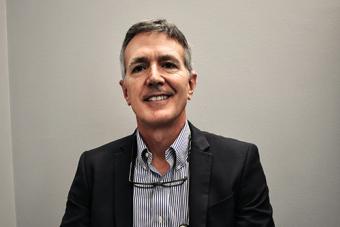Studying the Effects of Empathetic Healthcare Through the CHER Program
By Stephanie Zeller
A hand surgeon and a communication expert may be an unlikely duo in many research settings. But this unlikely pair is a prime example of how the Center for Health Communication’s CHER grant program is achieving its goal of interdisciplinary partnerships to improve health and care through empathy and other evidence-based communication sciences. Together, along with their research team, the otherwise odd couple will aim to bridge the communication disconnect between patients and providers.
David Ring, MD, PhD, Associate Dean for Comprehensive Care and Professor of Surgery at the Dell Medical School, along with colleagues Joost Kortlever, MD and PhD candidate, and Laura Brown, PhD and postdoctoral fellow at the Moody College of Communication, have begun research with the help of the CHER grant to identify important elements of empathetic communication between a patient and their doctor.
This patient/provider gap is not an easy one to bridge. Beyond educational differences, there are also issues of access to information, a patient’s feeling of personal agency, and numerous psychological factors that widen the gap and that make it even more difficult to establish a viable line of communication.
Contributing Factors
Dr. Ring first became interested in holistic care while analyzing patient reported outcome measures—a way for patients to rate their own health and wellness. It became clear that the criteria for health according to patients is not at all the same as what orthopedic surgeons (like himself) are taught to focus on.
“I had to start focusing on the whole individual…I had to become a student of communication and of psychology,” said Ring. “I had never interacted much with people who had a communications background, but I got here, and I realized…Oh, I should have done this a long time ago.”
Ring conducted a previous study also focusing on empathy. The results indicated that when patients rate satisfaction and empathy, they appear to be rating almost exactly the same thing. The two measures – and emotions – are highly correlated.
“People feel that if their doctor cares about them, they have a good experience during their visit,” said Ring. “But what we don’t know is if the patient’s perception of the doctor’s care corresponds with how well the doctor actually demonstrated care.”
In other words, a doctor can present information and make recommendations to his/her patient, but according to the research, if the doctor does not demonstrate effective communication strategies, the patient is much less likely to feel satisfied with their visit.
“There’s a misconception that a longer doctor’s visit is better, but evidence shows it is actually the patient’s perception of their provider’s empathy that matters, rather than the length of the visit,” said Dr. Brown.
These findings demonstrate communication’s vital role in medical care. However, according to Ring, even if we teach all doctors to communicate more effectively and to be more palpably empathetic, there will still be some disconnect. Understanding the root of these missed connections, these outliers, will be the predominant focus of the team’s research with CHER.
Methodology and GoPros
This study will focus on developing a better understanding of instances where perceived empathy and satisfaction, which have been previously established as highly correlated, diverge from objectively rated communications strategies.
The study will consist of two hypotheses: (1) to measure the correlation between objectively measured communication strategies and patient rated empathy, and (2) to measure the degree to which patient psychological factors (such as symptoms of depression, self-efficacy, and health anxiety) account for variation in the first hypothesis.
The team will recruit 120 new and follow-up patients currently seeing an orthopedic, plastic, or trauma surgeon. Each visit will be taped using a GoPro camera. After the visit, patients will complete a questionnaire that includes demographic questions, the Jefferson Scale of Patient Perceptions of Physician Empathy, Patient Reported Outcome Measurement Information System Depression, a Pain Self Efficacy short form, and a Short Health Anxiety Inventory short form. Physicians will also complete a questionnaire containing: sex, age, specialty, and years of experience.
Two independent raters, both communication students from the Moody College of Communication, will code and rate the taped visits separately using the Liverpool Communication Skills Assessment Scale.
The second portion of the study will entail in-depth statistical analysis of the rated and scored data. The team will use a bivariate analysis through Pearson’s correlation to assess the relationship between objectively measured communication strategies and patient perceived empathy, accounting for other factors. They will then use a multivariable linear regression analysis to evaluate these other factors.
Next Steps
The team expects the results of their study to illuminate the point of intersection between a patient’s misconceptions and a clinician’s communication skills. Often, when a patient walks into an appointment, they are overwhelmed with a lot of unfamiliar information in a short amount of time.
“Patients often remember just 30-40% of a visit, maybe less,” said Kortlever. “A big part of that is the physician talking too much.”
Kortlever adds that through this study and in the future, the team hopes to create and promote the use of decision aids—online, interactive forms that give the patient educational and risk information prior to their visit. At the end of a risk questionnaire, the patient will receive scores that inform both the patient and their doctor of how they feel concerning a possible procedure or treatment.
“People talk about a hierarchy of expertise, knowledge, power, control…we’re constantly trying to find ways to balance that,” said Ring. “Rather than trying to make a 15-minute office visit the most efficient thing possible, I think spreading it out over time would prepare both sides much better.”
“We don't want people to feel that we don't care, to feel dismissed, to feel that we’re belittling their concerns or that we’re being arrogant, like we know it all. We don’t want people to feel that way, and yet they do,” said Ring. “But we’re learning, and consequently getting better, and as we get better, people will get healthier. By doing research…you can help other people beyond just the ones you are treating. That’s what we hope to do.”
The Center for Health Communication is as a joint academic center of both Moody College of Communication and Dell Medical School at the University of Texas at Austin. It was established in 2014 to bring together researchers and experts from diverse backgrounds of health communication into one organizational unit where they can collaborate, share ideas and innovations, and advance their scholarship. It is an interdisciplinary group whose goal lies in improving health through evidence-based communication research, thereby advancing the health of people and populations.
About the Author
Stephanie Zeller is a rising senior at the University of Texas at Austin studying Public Relations in the Moody College of Communication, Studio Art in Fine Arts, and McCombs School of Business foundations certificate. Stephanie has a special interest in health, as well as in astronomy and biology and will begin to marry her varied interests during a public affairs internship with NASA in the summer of 2018. She hopes to build a career around writing and creating visual works to bridge what she views as an unnecessary gap between the arts and the sciences.




